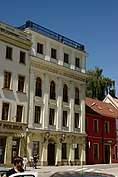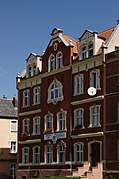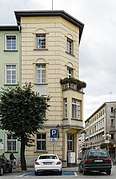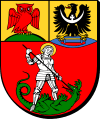Dzierżoniów
Dzierżoniów (Polish: [d͡ʑɛr'ʐɔɲuf] (![]()
Dzierżoniów | |
|---|---|
 .jpg)  
| |
 Flag  Coat of arms | |
 Dzierżoniów 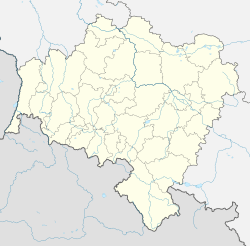 Dzierżoniów | |
| Coordinates: 50°43′41″N 16°39′04″E | |
| Country | |
| Voivodeship | |
| County | Dzierżoniów |
| Gmina | Dzierżoniów (urban gmina) |
| Established | 13th century |
| Town rights | before 1290 |
| Government | |
| • Mayor | Dariusz Kucharski |
| Area | |
| • Total | 20.07 km2 (7.75 sq mi) |
| Elevation | 261 m (856 ft) |
| Population (2019-06-30[1]) | |
| • Total | 33,239 |
| • Density | 1,700/km2 (4,300/sq mi) |
| Time zone | UTC+1 (CET) |
| • Summer (DST) | UTC+2 (CEST) |
| Postal code | 58-200 to 58-205 |
| Area code(s) | +48 74 |
| Car plates | DDZ |
| Website | Dzierżoniów.pl |
Established in the 13th century, Dzierżoniów is a historical Lower Silesian town that covers an area of 20.1 square kilometres (7.8 sq mi), and as of 2019 it has a population of 33,239. It is named after Polish priest and scientist Jan Dzierżon.[2]
Unique and architecturally rich, Dzierżoniów features a central market square with elegant tenements and a town hall as well as few museums and restaurants. The Old Town is a venue for several annual events and fairs.[3]
History
In its early history until 1945, the town was known as Reichenbach; composed of the German words reich (rich, strong) and Bach (stream), it refers to the current of the Piława River.[4] The name was rendered in Polish as Rychbach. To differentiate between other places named Reichenbach, the Lower Silesian town became known in German as Reichenbach im Eulengebirge, or "Reichenbach in the Owl Mountains".
Middle Ages
In the early Middle Ages, the area was inhabited by the tribe of Silesians.[5] After short periods of Great Moravian and Czech rule, in the 10th century the region became part of the emerging Polish state.[5]
Reichenbach was first mentioned in a document dating to 13 February 1258.[6] The parish Church of St. George was also noted early on.[7] The town was part of various Piast-ruled duchies of fragmented Poland. The coat of arms, depicting Saint George slaying a dragon, was used by 1290 at the latest. The town passed successively from the Bishopric of Wrocław, to the Duchy of Ziębice, and to the Duchy of Świdnica-Jawor.[6] The Knights Hospitaller built a school and hospital in the town in 1338. In 1392 the town became part of the Kingdom of Bohemia.[8] It was plundered by the Hussites during the 15th-century Hussite Wars.[6]
Early modern era

The Habsburg Monarchy of Austria inherited the Bohemian throne in 1526 and became the town's new lords. Reichenbach developed into a trading center, especially for textiles and linen, during the 16th century.[9] The town suffered during the Thirty Years' War (1618-1648).[5] After the First Silesian War in 1742, most of Silesia, including Reichenbach, became part of the Kingdom of Prussia. In 1762 during the Seven Years' War, the region between Reichenbach and Schweidnitz (Świdnica) was the setting for the Battle of Burkersdorf between Prussia and Austria. It also saw the frustration of an Austrian attempt to relieve the Prussian Siege of Schweidnitz. In 1790 representatives from Austria, Prussia, the Dutch Republic, and Poland met at Reichenbach to discuss the Ottoman wars in Europe. In 1800, the town was visited by future president of the United States John Quincy Adams.[8]
19th and 20th century

In 1813, Tsar Alexander I of Russia met with King Frederick William III of Prussia here to organize the War of the Sixth Coalition. From 1816–1945 Reichenbach contained the district office for Landkreis Reichenbach (Reichenbach district). Until 1820 the town was the seat of a Prussian district president. In the 19th century, the town became one of the leading centers of textile production in Silesia.[8] In 1848 the Silesian Weavers' Rebellion took place here.[8] Reichenbach was connected to a rail network in 1855. It became part of the Prussian-led German Empire in 1871. During World War II, in 1944, the Germans established the FAL Reichenbach subcamp of the Gross-Rosen concentration camp, mainly for Jewish women from the Netherlands.[10] The town was occupied by the Red Army on 8 May 1945.
Reichenbach was transferred from Germany to Poland in 1945 after World War II. Many of its German inhabitants had fled earlier in 1945 before the war's end, while most of those who had stayed were subsequently expelled. The void was filled by Poles moving in, some of whom from the eastern part of the country that had been annexed by the Soviet Union.
In the period immediately following World War II, the town was known by different names. The municipal office, the local office and the railway administration all used different names for it: Rychbach (its traditional Polish name), Reichenbach and Drobniszew.[11] In one of the Polish Ministerial decrees of 1945, another name was used: Rychonek. In 1946 the town was renamed Dzierżoniów after the apiarist Jan Dzierżon; ironically, Germany also viewed Dzierżon as one of their own, and in 1936, as part of a Nazi effort to remove Slavic-sounding place names, his birthplace, Lowkowitz (now Łowkowice), was renamed Bienendorf ("Bee village") in his honor.
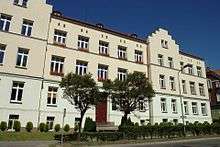
During World War II there was a large concentration camp in Lower Silesia, Gross-Rosen, with important branches in Rychbach and in two additional nearby towns. There were about 20,000 Jewish survivors of the camp, many of whom were Polish Jews. They did not want to go back to their hometowns because of the decimation of their Jewish communities and the fear of antisemitic violence. They were later joined by Polish Jews repatriated from the Soviet Union, and others who had survived in hiding in Poland or returned from concentration camps in Germany.[12]
Thus, the peak number of Jews in Dzierżoniów was 17,800 reached in November 1946[13] of the 50,000-Jew commune in Dzierżoniów County (incl. Bielawa, Pieszyce, Piława Górna, etc.) led by Jakub Egit from 1945–1948.[14]
One of the town's synagogues survived the war and has been restored.[15][16]
In the post-war period, the textile and electromechanical industry developed.[8] In 1945, the first radio receiver production company in post-war Poland, Zakłady Radiowe Diora, was founded in Dzierżoniów. Greeks, refugees of the Greek Civil War, settled in Dzierżoniów in the 1950s.[17]
Sports
Football team Lechia Dzierżoniów and handball team Żagiew Dzierżoniów are based in Dzierżoniów. Football players Krzysztof Piątek, Patryk Klimala, Jarosław Jach, Paweł Sibik all played in Lechia Dzierżoniów in the early stages of their careers, while handball players Paweł Piwko, Jan Czuwara, Dawid Dawydzik played in Żagiew Dzierżoniów in the early stages of their careers.
The annual Tewzadze Open chess tournament is held in Dzierżoniów, to commemorate Georgian-Polish military officer Valerian Tevzadze.[18]
Notable people
- Valerian Tevzadze (1894–1987), Georgian-Polish military officer
- Herbert Giersch (1921–2010), German economist
- Jacek Mickiewicz (born 1970), cyclist
- Piotr Wilczewski (born 1978), boxer
- Paweł Piwko (born 1982), handballer
- Krzysztof Piątek (born 1995), footballer
- Jan Czuwara (born 1995), handballer
Twin towns – sister cities
Dzierżoniów is twinned with:[19]






Gallery
 Municipal Museum of Dzierżoniów (Muzeum Miejskie Dzierżoniowa)
Municipal Museum of Dzierżoniów (Muzeum Miejskie Dzierżoniowa) Market Square (Rynek)
Market Square (Rynek) Town Hall (Ratusz)
Town Hall (Ratusz) Town Hall
Town Hall Church of St. Mary the Mother of the Church
Church of St. Mary the Mother of the Church House of Valerian Tevzadze
House of Valerian Tevzadze Panorama from the outskirts of the city
Panorama from the outskirts of the city Historic building
Historic building Historic townhouse
Historic townhouse Police station
Police station Bank building
Bank building- A water tower
References
- "Population. Size and structure and vital statistics in Poland by territorial divison in 2019. As of 30th June". stat.gov.pl. Statistics Poland. 2019-10-15. Retrieved 2020-02-14.
- o.o., StayPoland Sp. z. "Dzierzoniow". www.staypoland.com. Retrieved 20 June 2017.
- "Tourism - Dzierżoniów". www.dzierzoniow.pl. Retrieved 20 June 2017.
- Adrian Room. Placenames of the World. McFarland & Company, 2005. ISBN 0-7864-2248-3
- "Historia Gminy Dzierżoniów". Gmina Dzierżoniów (in Polish). Retrieved 5 October 2019.
- Um.Dzierzonow.pl. "History Archived 2007-01-14 at the Wayback Machine". Accessed December 7, 2006.
- Urlaub-Polen.de "Dzierzoniów / Reichenbach Archived 2006-12-05 at the Wayback Machine". Accessed December 7, 2006. (in German)
- "Historia Dzierżoniowa". Dzierżoniów.pl (in Polish). Retrieved 5 October 2019.
- Um.Dzierzonow.pl. "Geschichte Archived 2007-01-16 at the Wayback Machine". Accessed December 7, 2006. (in German)
- "Subcamps of KL Gross- Rosen". Gross-Rosen Museum in Rogoźnica. Retrieved 14 March 2020.
- http://src-h.slav.hokudai.ac.jp/coe21/publish/no15_ses/14_yoshioka.pdf
- ""A Place Where Polish-Jewish Relations Could Start Anew": Interview with Kamil Kijek". Archived from the original on 15 April 2015. Retrieved 20 June 2017.
- "History - Jewish community before 1989 - Dzierżoniów - Virtual Shtetl". www.sztetl.org.pl. Archived from the original on 22 March 2016. Retrieved 20 June 2017.
- Bożena Szaynok, "Żydowscy żołnierze z Bolkowa", Odra 1999, 9, p. 22-26, in Polish
- "The Dzierżoniów - Reinchenbach Synagogue Rescue Project - Beiteinu Chaj - 2004 Foundation". Archived from the original on 22 July 2009. Retrieved 20 June 2017.
- Gruber, Samuel (20 September 2009). "Samuel Gruber's Jewish Art & Monuments: Poland: Dzierżoniów Synagogue Reopens for Rosh Hoshanah". Retrieved 20 June 2017.
- Izabela Kubasiewicz, Emigranci z Grecji w Polsce Ludowej. Wybrane aspekty z życia mniejszości, p. 117 (in Polish)
- "X Tewzadze Open". Chess Arbiter Pro (in Polish). Retrieved 14 March 2020.
- "Miasta partnerskie". dzierzoniow.pl (in Polish). Dzierżoniów. Retrieved 2020-02-28.
External links
- Municipal website
- Jewish Community in Dzierżoniów on Virtual Shtetl
| Wikimedia Commons has media related to Dzierżoniów. |
